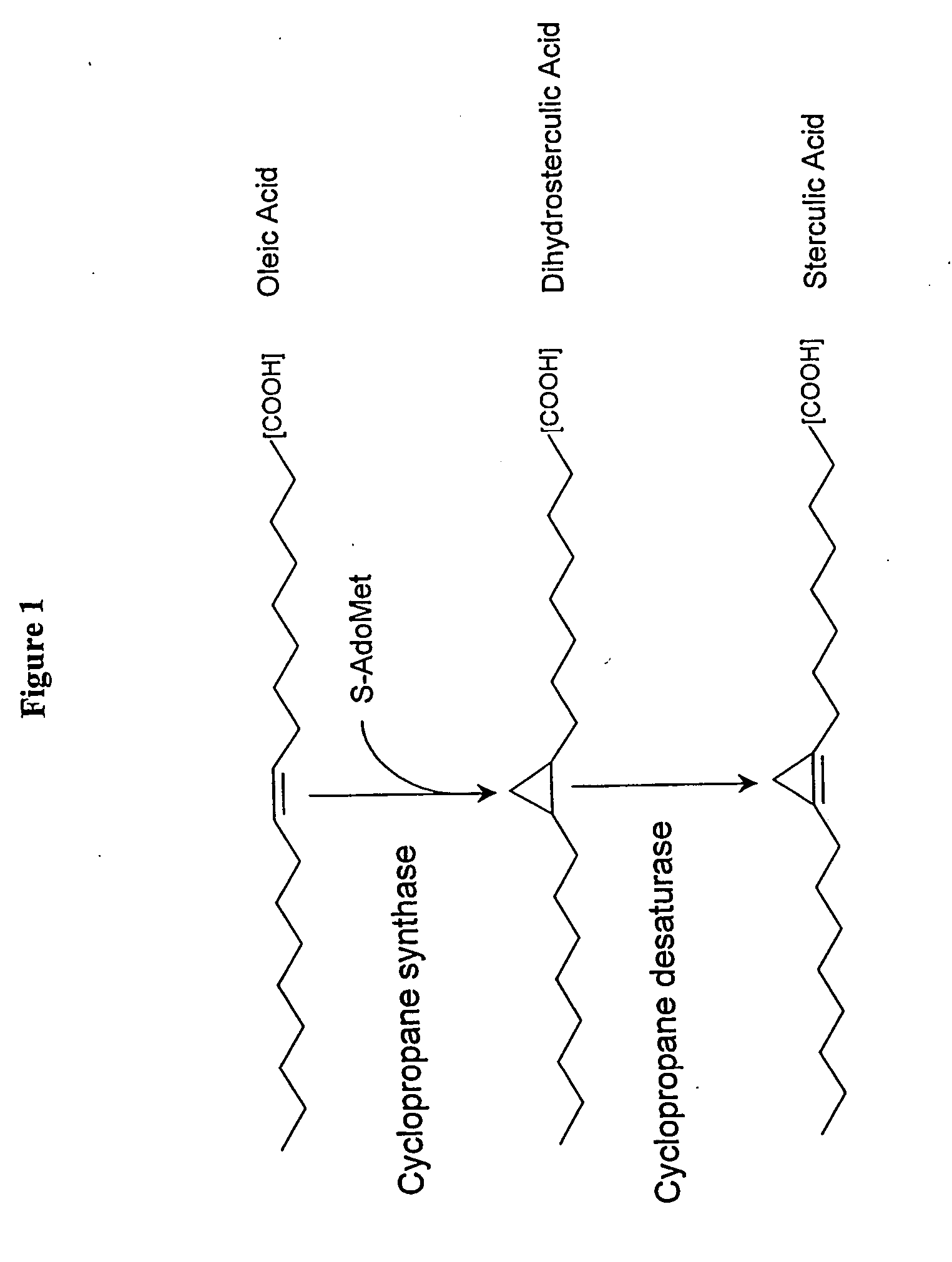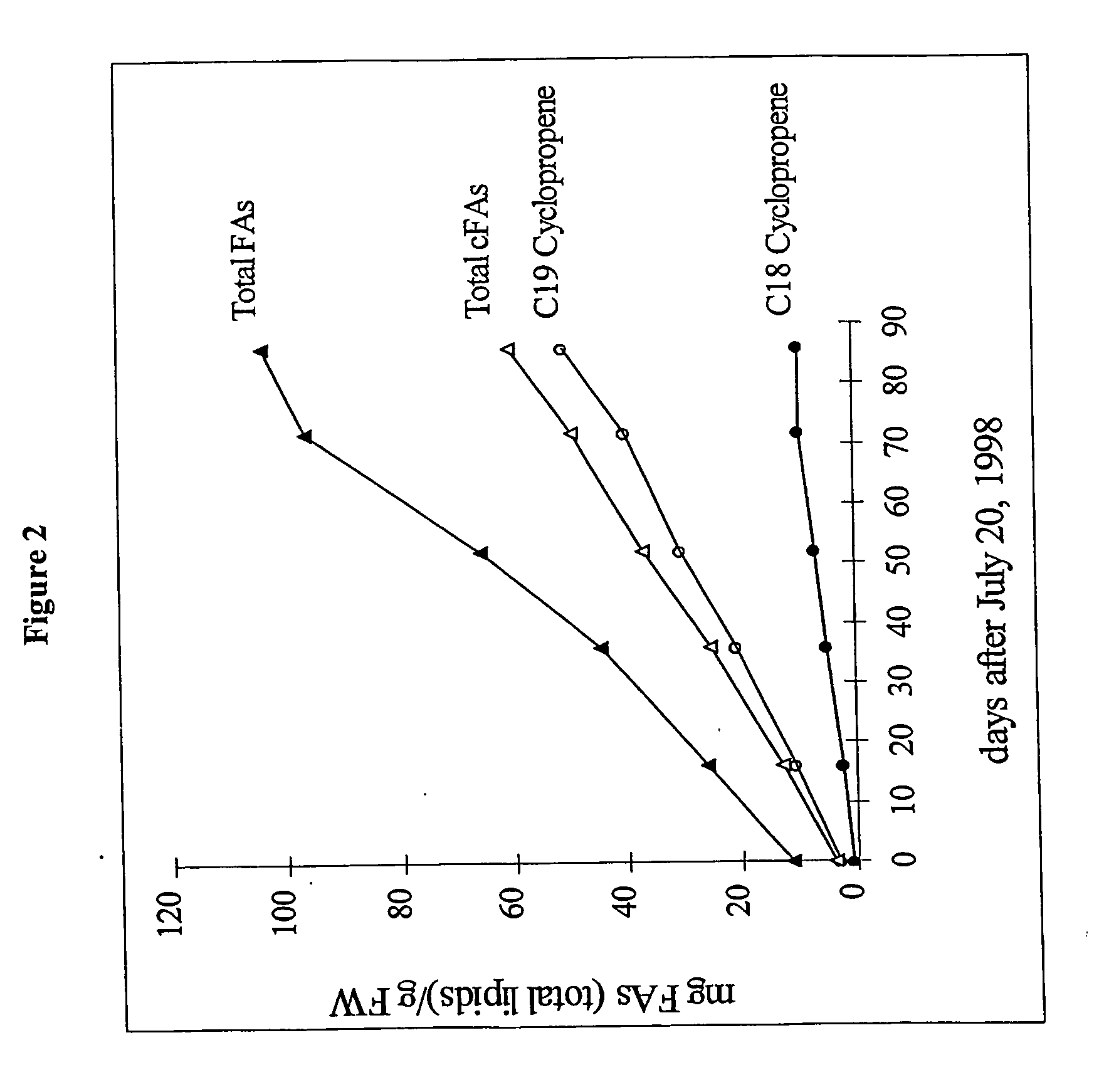Plant cyclopropane fatty acid synthase genes, proteins, and uses thereof
a technology of cyclopropane fatty acid and plant cyclopropane, which is applied in the direction of plant/algae/fungi/lichens ingredients, peptides, transferases, etc., can solve the problems of large amounts of methyl-branched fatty acids produced by hydrogenation, the presence of a certain percentage of trans fatty acids, and the addition of oil processing costs
- Summary
- Abstract
- Description
- Claims
- Application Information
AI Technical Summary
Benefits of technology
Problems solved by technology
Method used
Image
Examples
example 1
Experimental Procedures
Materials
[0306] Developing Seeds
[0307]Sterculia foetida developing seeds were collected from Jul. 20 to Oct. 15, 1998 at Miami Montgomery Botanical Center (Florida USA 331564242). Upon receipt of the fresh seeds, the seed coats were removed and the cotyledons and embryos were either immediately used fresh for labeling experiments or frozen and stored at −80° C. for subsequent RNA extraction and lipids analysis.
[0308] Tobacco Suspension Cells
[0309] Tobacco suspension cells (Nicotiana tabaccum L. cv. Bright yellow 2) were maintained in liquid medium containing Murashige and Skoog basal salts (Gibco, Grand island, NY), 3% sucrose, 2.5 mM MES / KOH pH 5.7, 1 mg / ml thiamine, 1 mg / ml myo-inositol, and 1:M 2,4-D. Cultures were sub-cultured weekly with 5% (v / v) inoculum from a 7-day old culture and shaken at 28° C. in 200 ml flasks.
[0310] Chemicals
[0311] Radio-isotopes, L-[methyl-14C] methionine (55 mCi / mmol), [1-14C] acetate (55 mCi / mmol) and [1-14C] oleic acid...
example 2
Identification of Cyclopropane Synthase from Sterculia foetida Developing Seeds Assay of Cyclopropane Fatty Acid Synthase
[0322] Frozen endosperm tissue, harvested from developing seeds of Sterculia foetida and stored at −70° C., was ground to a fine powder in liquid nitrogen. One weight of powder was thawed in two volumes of buffer containing 0.1 M Na tricine, pH 7.0, 1% w / v defatted BSA, 1% w / v PVP40, 15% v / v glycerol and 1 mM 2-mercaptoethanol. The slurry was briefly homogenized and filtered through miracloth. The filtrate was stored on ice. The residual paste was re-homogenized in two volumes of the above buffer, refiltered and the filtrate combined with the first filtrate. The combined filtrate, designated as “cell free homogenate” can be used for enzyme assay or subsequently fractionated. The use of tricine buffer (compared to tris or phosphate buffer), the use of pH 7.0 (compared to pH 6.4 or 7.8), and the addition of BSA and PVP40 (compared to no additions) each enhanced act...
example 3
Characterization of Cyclopropane Fatty Acid Synthase From Sterculia
Functional Analysis of the Putative SCPA-FAS in Yeast
[0332] Yeast cells possess several characteristics which make it a particularly useful test organism for evaluating whether the putative SCPA-FAS gene isolated from developing Sterculia seeds did in fact encode SCPA-FAS. These characteristics include the facts that yeast is a eucaryotic organism and that its fatty acid composition is very simple and consists only of 16:0, 16:1, 18:0, and 18:1. Thus, if dihydrosterculic acid could be detected in yeast transfected with a gene encoding SCPA-FAS, it would confirm that the SCPA-FAS is functioning as a cyclopropane synthase.
[0333] The yeast expression vector pYES2 / CT was used, and the SCPA-FAS coding sequence was placed under the under the control of a galactose inducible promoter, as described above. Yeast was transfected with the expression vector and grown also as described above. Under the assumption that oleic a...
PUM
| Property | Measurement | Unit |
|---|---|---|
| retention time | aaaaa | aaaaa |
| retention time | aaaaa | aaaaa |
| pH | aaaaa | aaaaa |
Abstract
Description
Claims
Application Information
 Login to View More
Login to View More - R&D
- Intellectual Property
- Life Sciences
- Materials
- Tech Scout
- Unparalleled Data Quality
- Higher Quality Content
- 60% Fewer Hallucinations
Browse by: Latest US Patents, China's latest patents, Technical Efficacy Thesaurus, Application Domain, Technology Topic, Popular Technical Reports.
© 2025 PatSnap. All rights reserved.Legal|Privacy policy|Modern Slavery Act Transparency Statement|Sitemap|About US| Contact US: help@patsnap.com



